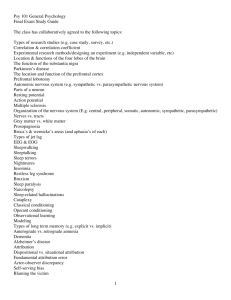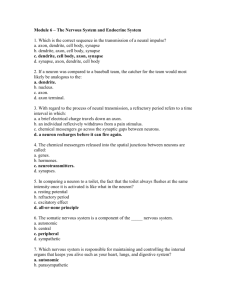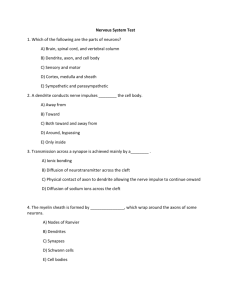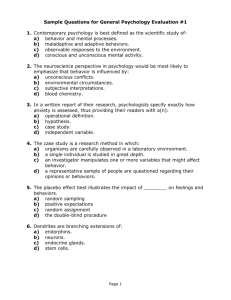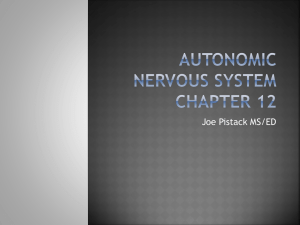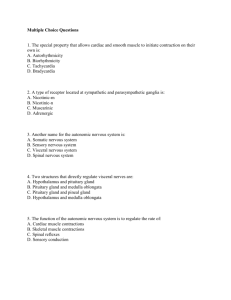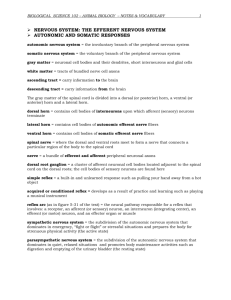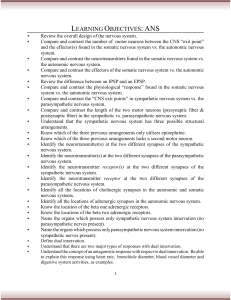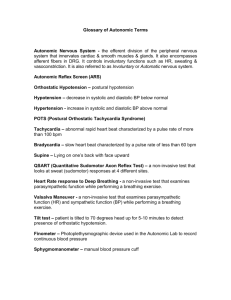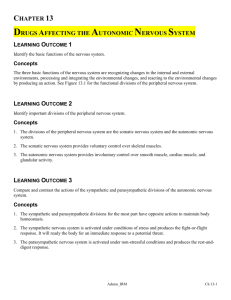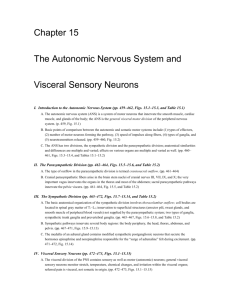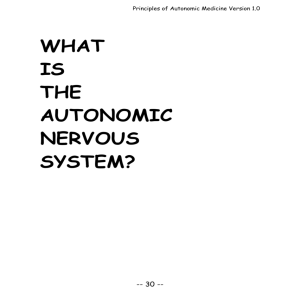Practice TestBiological Function1test
advertisement
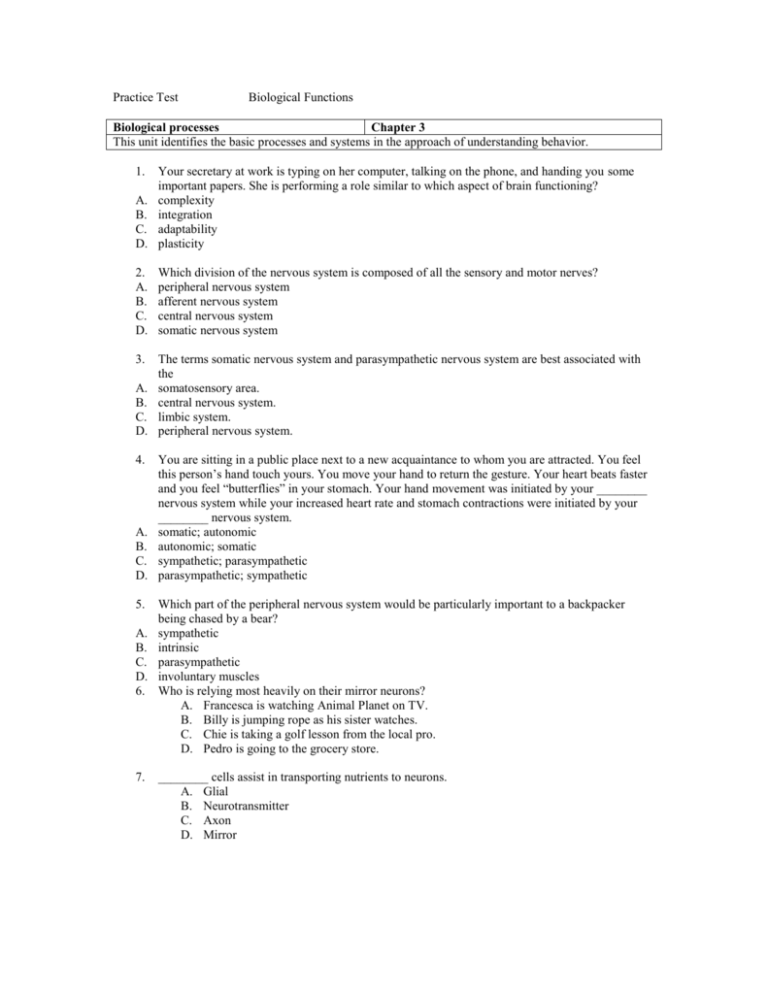
Practice Test Biological Functions Biological processes Chapter 3 This unit identifies the basic processes and systems in the approach of understanding behavior. 1. A. B. C. D. Your secretary at work is typing on her computer, talking on the phone, and handing you some important papers. She is performing a role similar to which aspect of brain functioning? complexity integration adaptability plasticity 2. A. B. C. D. Which division of the nervous system is composed of all the sensory and motor nerves? peripheral nervous system afferent nervous system central nervous system somatic nervous system 3. The terms somatic nervous system and parasympathetic nervous system are best associated with the somatosensory area. central nervous system. limbic system. peripheral nervous system. A. B. C. D. 4. A. B. C. D. 5. A. B. C. D. 6. 7. You are sitting in a public place next to a new acquaintance to whom you are attracted. You feel this person’s hand touch yours. You move your hand to return the gesture. Your heart beats faster and you feel “butterflies” in your stomach. Your hand movement was initiated by your ________ nervous system while your increased heart rate and stomach contractions were initiated by your ________ nervous system. somatic; autonomic autonomic; somatic sympathetic; parasympathetic parasympathetic; sympathetic Which part of the peripheral nervous system would be particularly important to a backpacker being chased by a bear? sympathetic intrinsic parasympathetic involuntary muscles Who is relying most heavily on their mirror neurons? A. Francesca is watching Animal Planet on TV. B. Billy is jumping rope as his sister watches. C. Chie is taking a golf lesson from the local pro. D. Pedro is going to the grocery store. ________ cells assist in transporting nutrients to neurons. A. Glial B. Neurotransmitter C. Axon D. Mirror 8. 9. Which of the following best describes how information is transmitted within a neuron? A. cell body → dendrite → axon B. dendrite → cell body → axon C. axon → dendrite → nucleus D. nucleus → dendrite → axon E. Depolarizing the membrane during an action potential first involves the flow of ________ ions into the membrane. A. sodium B. potassium C. serotonin D. dopamine 10. Broca's area is located in the ________ hemisphere. A. left B. right C. parietal D. occipital 11. The ability for nerve cells in the brain to change their purpose demonstrates what capacity of the brain? A. plasticity B. electrochemical transmission C. complexity D. lesioning 12. Which of the following is a role of the autonomic nervous system? A. controls motor neurons B. monitors essential processes C. conveys information to the CNS about temperature D. controls sensory neurons 13. You are sitting in a public place next to a new acquaintance to whom you are attracted. You feel this person’s hand touch yours. You move your hand to return the gesture. Your heart beats faster and you feel “butterflies” in your stomach. Your hand movement was initiated by your ________ nervous system while your increased heart rate and stomach contractions were initiated by your ________ nervous system. A. somatic; autonomic B. autonomic; somatic C. sympathetic; parasympathetic D. parasympathetic; sympathetic 14. The neurobiologist explained to the students, “The neural system is very much like the wires connecting your T.V. and stereo to the electrical outlet. If the wires were not covered with insulation, the signal would short circuit.” The neurobiologist was describing the function of the A. terminal button. B. axon. C. cell body. D. myelin sheath. 15. Depression is associated with low levels of what neurotransmitter? A. acetylcholine B. serotonin C. dopamine D. norepinephrine 16. Based on the research on oxytocin, if Julia finds herself in a stressful situation she is most likely to A. run away. B. stay and confront the stressor. C. call a friend. D. react as if nothing is wrong. 17. The practice of women bringing food to other women during times of crisis may have been triggered by which neurotransmitter? A. GABA B. serotonin C. dopamine D. oxytocin 18. Magnetic resonance imaging is a technique that works by A. measuring the rate at which brain cells use glucose. B. constructing a three-dimensional image from X rays. C. transducing the electrical activity of individual neurons. D. detecting and interpreting magnetic activity from hydrogen levels in the blood. 19. When combined with brain-imaging techniques, transcranial magnetic stimulation allows researchers to A. draw cause and effect conclusions. B. apply correlational inferences. C. make naturalistic observations. D. eliminate bias from their work. 20. The ________ is the part of the hindbrain that is involved in sleep and arousal. A. pons B. medulla C. cerebral cortex D. thalamus 21. Who would benefit the most from a highly efficient cerebellum? A. baseball player B. teacher C. salesperson D. composer 22. Joe has brushed his teeth seven times this morning. More than likely, he has a damaged A. amygdala. B. thalamus. C. hippocampus. D. hypothalamus. 23. Theus is about to take the Bar Exam. Which lobe of the brain will he be relying on most to do well? A. frontal B. occipital C. temporal D. parietal 24. What area of the brain is associated with the recognition of faces and/or the recognition of other familiar objects? A. amygdala B. hippocampus C. fusiform face area D. Wernicke’s area 25. Professor Travis noticed that a large book was sliding out of the shelf and was about to hit the top of the computer. He moved quickly to intercept the book before his computer could be damaged. The movement of his hand was a result of a process in the A. limbic system. B. motor cortex. C. pons. D. temporal lobe.
